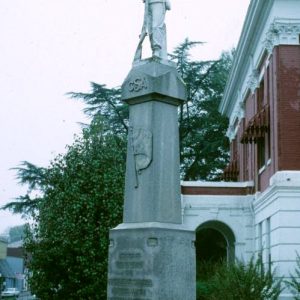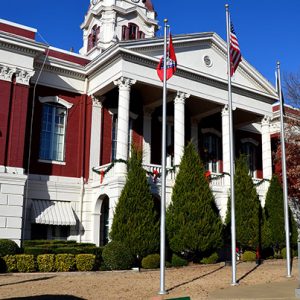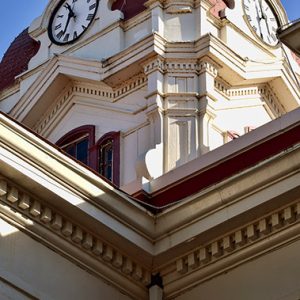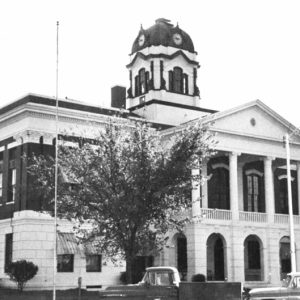calsfoundation@cals.org
White County Courthouse
The White County Courthouse in the northeastern Arkansas city of Searcy (White County) is located in a historic district. The courthouse has hosted many local events over the years ranging from farmers’ markets to the annual Get Down Downtown festival. The Arkansas Historic Preservation Program recognizes the White County Courthouse as historically significant, and it was added to the National Register of Historic Places on August 3, 1977.
White County built its first courthouse when the county was still in the Arkansas Territory. In 1835, one year before Arkansas’s statehood, the Territorial Legislature created White County and established a five-man commission to determine its county seat. David Crise, one of the commissioners, hosted the local government in his home, which later became the site of Oak Grove Cemetery. The commission selected a location in Searcy in 1840 and developed a tract of ten acres donated by local War of 1812 veteran Crawford Walker. The county began construction on a one-story log cabin, at the cost of $138.50, on the same site that accommodates the White County Courthouse in the twenty-first century. The donated land originated from a land grant that the federal government awarded to veterans of the War of 1812. However, a legal dispute arose over its ownership when Israel Moore—a surveyor from Philadelphia, Pennsylvania—claimed that he originally owned the land. The legal dispute eventually ended at the U.S. Supreme Court, which decided that Moore indeed owned the ten acres. However, Moore honored Walker’s donation and granted the land and the 1840 building to the county. This situation made White County’s courthouse unique, as it is the only courthouse in Arkansas that has a location determined by the nation’s highest court.
Between 1840 and 1850, White County’s population rose by 181 percent, resulting in the need for a larger courthouse. Construction was completed on a two-story, wood-framed courthouse at a cost of $1,000 in 1850. Only nine years passed before White County planned to build again, with construction slated to start in April 1861. But the start of the Civil War delayed the plans for a new courthouse. Additionally, because the county sold the 1850 courthouse to a buyer that moved it offsite and reopened it as the Burrow Hotel, White County needed to find temporary housing for its county business. The county moved its court to a masonic lodge with a $450 annual rent, until the county court appropriated $25,000 for the current White County Courthouse in 1869.
H. L. Baldwin of Memphis, Tennessee, designed the building in the Georgian style, complete with Corinthian columns and a clock tower with a bell made in 1855 resembling the famous Liberty Bell. With the contrast of white, cut stone on the first floor and maroon brick on the second floor, the White County Courthouse is an aesthetically striking building. Wyatt Sanford of Searcy completed the construction in 1871, with costs that exceeded the original estimates.
No alterations were made on the building over the next forty years, except for the installation of gas lamps on the square in 1878, a new tin roof in 1878, and the placement of an iron fence in 1888. In 1912, White County remodeled and expanded the courthouse by adding north and south wings to the building, which added needed space. Frank Gibb, a renowned architect in Arkansas, designed the additions.
Several war memorials stand on the courthouse lawn, including a marble Confederate monument (listed on the National Register on April 26, 1996) that depicts a Confederate soldier with his rifle. It was unveiled at a Confederate reunion and just months after United States’ 1917 entry into World War I. With Confederate veterans and Searcy locals in the crowd, speakers urged the young to enlist in the armed forces and reminded the old of the solidarity needed on the homefront. A granite monument dedicated to veterans of World War I, World War II, and the Korean War stands in front of the courthouse. Dedicated on May 30, 1998, it was designed to complement a separate Vietnam War monument placed there in 1984. Speakers at the dedication included U.S. congressman Vic Snyder and state senator Mike Beebe.
For additional information:
Biographical and Historical Memoirs of Eastern Arkansas. Chicago, IL: Goodspeed Publishing Co., 1890.
Christ, Mark. “A Stately Lady.” County Lines Magazine (Winter 2015).
Gill, John Purifoy, and Marjem Jackson Gill. On the Courthouse Square in Arkansas. N.p.: 1980.
Mitchell, Steve, Jill Bayles, and Ken Story. “History and Architecture of White County.” Arkansas Historic Preservation Program. Online at http://www.arkansaspreservation.com/News-and-Events/publications (accessed August 27, 2020).
Muncy, Raymond Lee. Searcy, Arkansas: A Frontier Town Grows Up with America. Searcy, AR: Harding Press, 1976.
“Searcy Confederate Monument.” National Register of Historic Places nomination form. On file at Arkansas Historic Preservation Program, Little Rock, Arkansas. Online at http://www.arkansaspreservation.com/National-Register-Listings/PDF/WH2320S.nr.pdf (accessed August 27, 2020).
“White County Courthouse.” National Register of Historic Places nomination form. On file at Arkansas Historic Preservation Program, Little Rock, Arkansas. Online at http://www.arkansaspreservation.com/National-Register-Listings/PDF/WH0025.nr.pdf (accessed August 27, 2020).
Jared Craig
Arkansas Historic Preservation Program
 Historic Preservation
Historic Preservation Searcy Confederate Monument
Searcy Confederate Monument  White County Courthouse
White County Courthouse  White County Courthouse
White County Courthouse  White County Courthouse
White County Courthouse 




Comments
No comments on this entry yet.